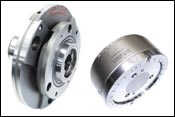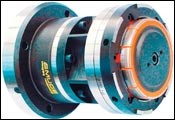Selecting The Right Workholding Solution
These tips help solve turning, grinding and milling workholding problems, particularly for thin wall parts.
With manufacturing operations using higher cutting speeds that place greater force on workholding equipment, choosing the correct system to hold on to the work is trickier than ever. Careful examination of the specific clamping application may lead to either a ready-made solution or a customized workholding answer.
One vendor, Emuge Corp. (West Boylston, Massachusetts), has a workholding division that provides tailored solutions to troublesome workpieces and manufacturing. This division specializes in fixtures that demand high accuracy and repeatability across a broad market, including low-volume job shops through high-volume automotive production environments.
Mr. Dave Jones, Emuge precision workholding manager, explains, “Our workholding group stays close to our customers to learn about their unique challenges and production environments. Doing so helps us avoid potential miscommunication and minimizes additional project costs.”
Mr. Jones and his team offer the following tips for obtaining a unique clamping solution for specific situations.
Difficult Workpiece Considerations
Most situations requiring a custom workholding solution involve a difficult workpiece and/or operating environment. For instance, one challenge is holding very thin-wall parts while performing operations with high transferable torque values. In these operations, the workpiece can have a tendency to deform. Emuge’s System SG (based on a series of short tapers) spreads the clamping forces over the largest possible area of the workpiece. The result is a very rigid, accurate and repeatable workholding solution for these types of difficult workpieces. This workholding system is commonly used for hobbing, shaping, shaving, turning, grinding and inspection applications.
Ensure Accuracy
Not only should the clamping system be precise, but several other related areas of the operation should also be reviewed to ensure the best possible results. The production environment and tooling must be suitable for the application. Just because it worked in the past doesn’t mean it is still effective. The accuracy of the locating and clamping surfaces on the workpiece should also be considered. Further, a clean workpiece yields the best end product. When debris builds up in the clamping area of a workpiece, it may affect how the piece is being held, and negatively affect the outcome of the entire operation.
The volume of work to be performed on the workholding devices should also be considered. In some industries a high volume can be 10,000 parts per month or less. In other industries, 50,000-plus parts per month would be high volume. According to Mr. Jones, the relationship of these quantities to workholding is important. “The workholding device must maintain its accuracy throughout the volume of workpieces required with as little maintenance as possible,” he says. “This is when you start to talk about longevity and reliability of the workholding device itself. Generally speaking, wherever possible, Emuge offers mechanical workholding solutions as opposed to hydraulic solutions, to provide that extra longevity, accuracy and reliability.”
There are, however, instances where the workpiece has a challenging bore-to-length ratio. An example would be a small-diameter bore with an overall part length, which is 2× the bore diameter. In these instances, a hydraulic system may be the correct alternative because of the workpiece geometry and perhaps the lack of spacing required for a mechanical solution. The trade-off in precision workholding with a hydraulic device, especially in the case of higher volume work, is that the hydraulic sleeve or clamping surface is, in most cases, integral to the device itself. This means that if the sleeve wears or develops a leak, then the majority of, if not the entire workholding device, needs to be replaced. In a mechanical system, however, the part-touching details would be considered easily replaceable in the event of failure.
While hydraulic arbors may be a natural choice for applications where extremely high accuracy such as 2-micron runout may be required, a mechanical solution could be more effective in cases where the volume is considered to be high and the desire to maintain mechanical reliability is a key factor. According to Mr. Jones, “The System SP is our most accurate system. This system is capable of a runout of 2 micron, similar to a hydraulic arbor, yet touting the reliability of a mechanical system. The system can also be used in other high-accuracy areas such as toolholding, grinding or workpiece inspection.”
Planning Ahead
The clamping solution of choice should be one that not only is effective now, but will suit the needs of the shop well into the future. When the vendor is designing the fixture, the shop should convey what its needs will be down the line as well. Perhaps the workpiece is one of many in a series or part family, which could mean that relatively minor changes would have to be made to the workholding device to accommodate the new workpieces.
Emuge’s workholding systems are designed to adapt to workpiece changes within a range. In some cases, a change in diameter would require only a new clamping sleeve or expanding bush that is designed to match the new clamping diameter of the new workpiece in the family. This adaptability within a range has advantages in quick change-over, where time is money, but can also reduce the number of basic assemblies required to manufacture a complete part family line.
Selecting the best workholding system for a given application ultimately leads to a better end product. By adhering to sound principles in choosing the workholding solution, and by maintaining a good and open relationship with the vendor, a shop can meet the challenges of today’s demanding production environments.
Establish Open Communications
The vendor should have an open ear beginning early on in the quotation process. It is critical that the vendor understands the requirements for the entire operation. Although not always immediately evident, some of this information may prove to be essential to the success of the workholding system.
The vendor must have complete operation specifics and then must remain informed of any changes to these specs, even if the modifications do not appear to be workholding related.
Mr. Jones explains further, “When we stay close to our customer and keep a steady flow of communication, we are usually kept informed without even asking. However, even when we are receiving timely updates, changes to the original specs may lead to some added cost or a delay in project delivery because the design or build process may be too far along.
“In most cases our designs allow us to react and adapt quickly to minimize the impact of unforeseen changes. There was a time when a customer didn’t tell us about a special clearance problem and another time when a customer changed the specs on a grinding wheel design. These unexpected variables really put the flexibility of the workholding devices to the test.”
Related Content
Shop Sets its Sights on Precise Tool Alignment
A Wisconsin shop has found that visual tool alignment technology has improved tool life and surface finishes for its Swiss-type lathes while increasing throughput as well.
Read MoreBreaking the Barriers for Small Tool Breakage Detection
This contact-free tool breakage detector, especially useful for machine tools with small tools and small workzones, offers a quick and efficient way to change out broken tools before they cause bigger problems.
Read MoreMaking Micro Threads
Production of micro threads can be challenging, but using the most suitable tools for a given application can simplify the task.
Read MoreThe Value of Tool Monitoring on Rotary Transfer Machines
By using a tool monitoring system, shops can save costs associated with machine maintenance and downtime for tool changes while increasing cutting performance.
Read MoreRead Next
Workholding For Swiss Turning
In large part, because of the machine’s versatility, Swiss turning is increasing its penetration of the precision turned parts market. As more shops look to this technology, a look at workholding considerations is in order.
Read MoreA Tooling Workshop Worth a Visit
Marubeni Citizen-Cincom’s tooling and accessory workshop offers a chance to learn more about ancillary devices that can boost machining efficiency and capability.
Read MoreEmerging Leaders Nominations Now Open
Here’s your chance to highlight a young person in your manufacturing business who is on the path to be a future leader moving your company forward.
Read More.png;maxWidth=970;quality=90)












.png;maxWidth=300;quality=90)













.png;maxWidth=970;quality=90)